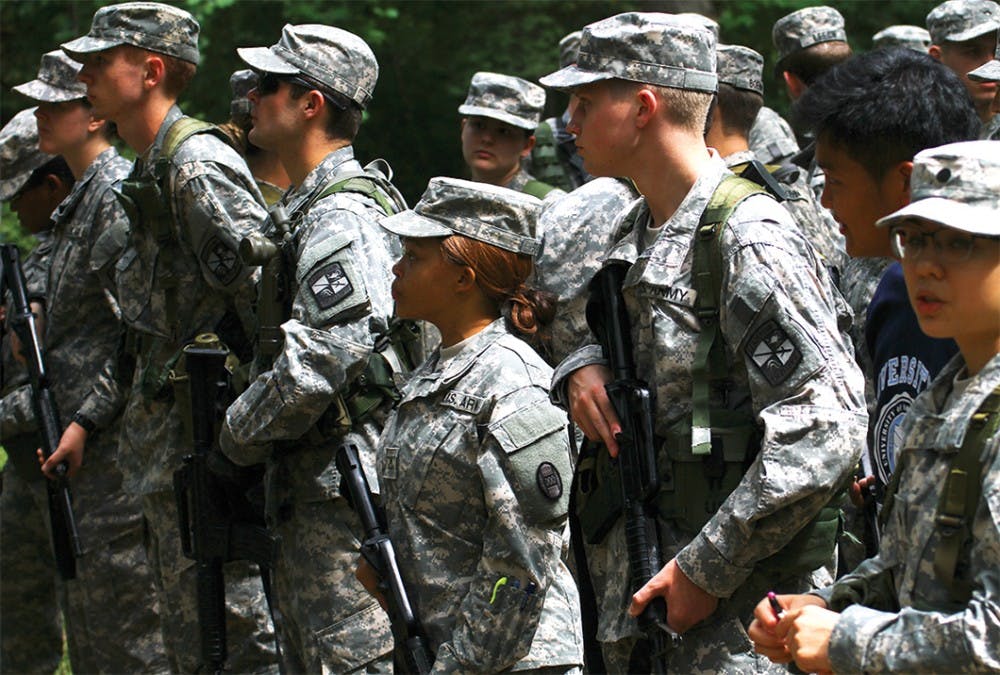Some, like Kit Kenny, a junior political science and PWAD double major, will dart straight off to 8 a.m. classes after this, only to come back in the afternoon for leadership classes and more training.
This is part of the student experience in UNC’s Army Reserve Officers’ Training Corps. Forty cadets of the 60 students affiliated with the ROTC branch are preparing to go into active duty after they graduate — or continue on to study medicine or law.
“It’s not like, ‘Oh, hey, I’m just here to do it,’” Kenny said. “It’s ‘here because I have a lot of big future goals in mind,’ and either way, the Army’s going to help you.”
Capt. Jared Miller, executive officer of the Tar Heel Battalion Army ROTC, said these cadets are training not only to be soldiers, but also to be leaders of soldiers. And these ROTC students might be an important key to bridging the gap in the future.
“ROTC programs provide the opportunity to connect the military to elite college students who, even if they’re not in the military, now they have a roommate who’s in the military, or they have a friend in their class who is in the military,” Feaver, the political science professor, said.
He said while several major schools in the South, such as Texas A&M University, could likely provide the military with all the officers it needs, maintaining a distribution of ROTC programs across campuses like UNC and Duke is a much better approach for addressing the military-civilian divide.
For cadets at UNC, the program plays a major role in the way they experience college, but it doesn’t separate them from traditional students.
A lot of cadets, Miller said, are headed toward medical fields — meaning many of them juggle biology and chemistry majors while keeping up with their ROTC duties.
Madison Farr, for example, is a senior nursing student who joined ROTC the second semester of her first year at UNC and will become an Army nurse when she graduates.
Farr, like Kenny, said her friends at UNC who aren’t in ROTC are supportive of and interested in her program involvement.
“Usually the only disconnect is that people just don’t know a lot about it,” she said. “For the most part, everyone is supportive and wants to know about what I do, just like I want to know about what they do.”
‘It’s up to us’
To get the day's news and headlines in your inbox each morning, sign up for our email newsletters.
The majority of students on UNC’s campus come from a generation far removed from military service, and studies suggest that the divide between military and civilians is more pronounced among younger people.
A 2011 Pew Research Center poll entitled “The Military-Civilian Gap” found that only 33 percent of adults between the ages of 18 and 29 had an immediate family member in the military, compared with 77 percent of adults older than 50.
David Rohall, the head of the sociology and anthropology department at Missouri State University, has studied the military-civilian gap between 18- to 22-year-olds for 10 years. He said it’s difficult to qualify the exact reasons for a divide. Factors from gender to ideology contribute; the military tends to attract conservative males, for instance, while the average college campus skews female and liberal.
But one way or another, experts agree that in many cases, the gap fosters mistrust and resentment between military and civilians.
A 2014 Gallup poll showed that confidence in the military is at 72 percent — but Feaver said the portion of Americans holding up that confidence comprises Republicans, veterans and older people. Among Democrats and younger people, he said, those numbers are considerably lower.
“So even though there’s not currently a problem with public distrust of the military, the trend line suggests that it might become a problem going forward,” he said.
On UNC’s campus, the CVO is working to build camaraderie between student veterans and traditional students.
A Daily Tar Heel survey of 120 students showed that nearly half of those surveyed were interested in knowing more about military life; 75 percent of respondents did not think the general public sufficiently understands military life.
“It’s up to us,” said Michael Hart, a senior PWAD major and the CVO’s president. “Nobody else can educate the community on what’s happening. We’re here walking around with each other. We’re in classrooms together.”
The CVO is organizing a “Ruck for Hunger” in October, a re-creation of a military exercise designed to deliver canned goods to several locations around Chapel Hill. Hart said he hopes it will be an inclusive event that gives traditional students an opportunity to interact more with student veterans.
Andrew Reeves, a senior political science major who served for 12 years in the Marines, said it’s important, too, for the community to understand that many student veterans are approachable and shouldn’t be thought of homogeneously.
“As a whole, veterans are a reflection of society in general. We come from various backgrounds. We don’t all think the same way. Most of us have different political ideologies,” he said. “We don’t fit into this rigid box.”
@lindseynbrunson
special.projects@dailytarheel.com



